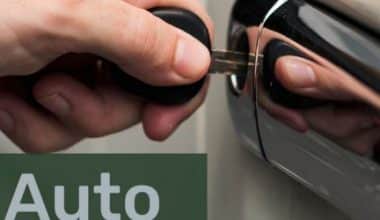Car ownership has always been linked to an unending sense of possibility and freedom. Numerous books, songs, and films have glorified the open road. It’s almost as if you’re driving off into a technicolor horizon while putting on the radio.
However, owning a car provides help for all your planned, unique excursions. But great driving comes with significant financial responsibility.
Choosing the right auto insurance may seem complex, regardless of whether you’re purchasing your first vehicle or your parents are telling you it’s time to obtain a policy. So we have taken the liberty to provide all you should know about auto insurance if you are doing this for the first time.
How to Obtain Your First-Time Car Insurance Policy
There are certain particular hurdles when purchasing auto insurance for the first time. You don’t have a driving history or an active insurance policy to increase your insurability and reduce your premiums as a new driver. Both young, inexperienced drivers and drivers without insurance at the moment are seen as high-risk. As a result, you’ll be required to pay a higher premium than an experienced or preferred driver.
Adding a new driver to an existing insurance policy is one technique to get around the higher costs for first-time insurance buyers. Rather than filing for your policy, you can obtain an automatic discount if your parents or spouse are current drivers and have a car insurance policy. As a first-time driver, you will still pay a more significant cost, but you will usually receive lower rates than you could get on your own.
Understanding the Needs for Car Insurance
When purchasing your first car insurance policy, you should learn about your state’s minimum coverage requirements. There are laws governing driver’s insurance in almost every state. Every state requires liability coverage on car insurance policies, except for New Hampshire. Twenty states mandate that you have uninsured motorist coverage, while seventeen states mandate that drivers have underinsured motorist coverage. States differ in terms of minimum coverage quantities as well.
Types of Coverage for Car Insurance
It is crucial to understand the various coverage options and what they entail when selecting a car insurance plan. Even while paying the state’s minimal requirements out of pocket is less expensive up front, this kind of coverage isn’t always the best option.
Spend some time comparing prices for the most affordable base coverage, but don’t forget to take advantage of the beneficial add-ons that your insurance company offers.
#1. Liability Coverage
Personal property damage and bodily injury are covered under liability insurance. It only covers other people’s losses and harms when you are at fault for the accident.
Liability insurance also assists with covering legal fees and any judgments or settlements awarded against you if you are sued for an automobile accident. As previously stated, this coverage is necessary on an auto insurance policy in every state but New Hampshire.
#2. Insurance for Collisions
Should you and another vehicle collide or strike an object like a tree, post, wall, or fence, your collision coverage will cover the cost of repairs to your car. If your automobile rolls over or topples over in a single-car collision, collision coverage may also help with repairs.
#3. Extensive Reporting
Everything you do while driving has nothing to do with the damage to your car. This is where complete coverage comes into play; it covers weather-related, theft-related, vandalized, and fallen tree repairs. Comprehensive insurance may also partially cover some of the damages from an animal accident.
#4. Coverage for Underinsured and Uninsured Drivers
Uninsured/Uninsured or underinsured coverage is mandated in certain states. Depending on the state in which you reside, this insurance may cover the cost of car repairs if you are in an accident with an uninsured or underinsured driver who cannot compensate for the harm they have caused. In addition, it will cover your passengers’ and your medical expenses as well as missed income and suffering.
#5. Defense Against Personal Injury
Personal injury protection, or PIP, covers costs related to injuries sustained in auto accidents. This insurance coverage can assist in paying for medical expenses, missed income, pain and suffering, rehabilitation fees, and even child care needed while you and your passengers heal, regardless of who is at fault.
PIP coverage is mandatory in sixteen states and Puerto Rico; it is an optional benefit in six states and Washington, D.C. If this coverage is offered where you live, it will depend on the motor vehicle legislation in your state.
#6. Medical Payment Coverage
Medical payment coverage will assist in covering part of the medical expenditures for injuries associated with an automobile accident. It covers you and your passengers and even kicks in if you are hurt as a pedestrian in an automobile accident. Even with health insurance, it typically doesn’t cover all your medical expenses. Coverage for medical payments helps close the gaps.
Things to Consider Before Getting a First-Time Car Insurance
Getting quotes for auto insurance before buying a car is also intelligent. You might not be allowed to drive your new automobile off the dealer’s lot if you don’t have insurance. Before being allowed to drive the car home, you must provide proof of insurance.
It’s a good idea to factor insurance costs into your budget in addition to loan payments and car upkeep. It’s a good idea to know which automobiles are the most and least expensive to insure before you complete the deal, even if numerous factors affect how much your insurance will cost. One such consideration is the type of vehicle you drive.
What you can do in advance is as follows:
#1. Consider a Make and Model
You’ve probably decided what kinds of cars you’re interested in while car shopping. For instance, you might be interested in taking a test drive of a used Honda Civic, or you might want a brand-new Toyota Camry. You can plan your budget by getting quotes from an insurance agent for a few different models.
#2. Recognise the Kinds of Coverage You Will Require
The majority of states mandate that you have auto liability insurance. Additionally, your lender or leasing agency will want collision and comprehensive insurance if you take out a car loan or lease.
#4. Examine Rates from Several Car Insurance Providers
An effective strategy to compare prices is to use an independent insurance agent or an internet vehicle insurance comparison website. You should get quotations from multiple insurance companies because rates can differ significantly. To ensure an apples-to-apples comparison, compare quotations for the same coverage level.
#5. Request that your insurance agent establish a policy
This portion is simple if you have already chosen the car and know its identification number (VIN). It is possible to prepare your coverage before you arrive at the dealership. Ask the agent if they can put up a policy using your details, such as the drivers in your household and the address where you plan to store the car if you don’t yet have the VIN. Once you’ve made up your mind about the vehicle, give the agent your VIN to finish buying auto insurance coverage.
First-Time Car Insurance Cost
According to an analysis, the average cost of car insurance with liability, collision, comprehensive, and uninsured motorist coverage nationwide is $1,998 for a good driver purchasing $100,000 in bodily injury liability per person, $300,000 per accident, and $100,000 in property damage liability.
How New Drivers Can Reduce Their Car Insurance Costs
You can do a few things to obtain a cheaper auto insurance rate, but there is no foolproof method to locate the cheapest deal. For new drivers, we advise you to use the following tactics while buying auto insurance:
#1. Evaluate Insurance Providers for Novice Drivers
You won’t receive an exact quote from two insurance firms. By comparing quotes from several auto insurance companies, you can determine how much you could save by switching insurance companies or what you should budget for when adding a new driver to an existing policy.
#2. Raise Your Credit Rating
Building strong credit before you start driving is a wise method to acquire lower auto insurance as a new driver because a low credit score can cause your premiums to increase.
Although it may seem impossible, there are many things you can do right now to boost your credit score. Here are seven easy methods to begin improving your credit score so that you can
#3. Search for Discounts on New Driver Car Insurance
Young drivers and students can receive discounts from some auto insurance providers, but other ways exist to minimize costs. Check to see if your insurer offers a multi-policy discount, since this might reduce your cost when you bundle products like homeowners insurance with your auto coverage.
#4. Modify the Coverage of Your Car Insurance
Changing your current auto insurance coverage could result in a better premium if you’re trying to save money and have a new driver on the road. Although choosing a higher deductible typically results in cheaper premiums, you must pay more upfront to make an insurance claim.
Removing unnecessary coverage is an additional choice. If you own it outright, you can cancel comprehensive and collision insurance on an older automobile. In most jurisdictions, you must still pay for liability insurance even if you want to cancel the remainder of your full coverage policy.
#5. Examine Insurance Based on Use
Usage-based auto insurance, called telematics insurance, tracks mileage and driving habits to determine premiums. According to the National Association of Insurance Commissioners, usage-based insurance policies typically cost customers less than standard auto insurance since they tie the monthly fee to real-time spent driving and safe driving practices.
Not all states may offer usage-based plans. Additionally, they’re not a wise choice if you drive frequently or have a long commute, and those with bad driving records may see an increase in their premiums.
What Affects the Cost of Car Insurance?
The average cost of auto insurance is hard to calculate because it varies a lot depending on your circumstances. The quotations you obtain will consider several important factors affecting your auto insurance cost. An insurance company considers these criteria to determine how hazardous it is for them to provide you with insurance coverage. Among the most typical elements are:
#1. Driving history
While a spotless record can help you secure the best deals, young people and inexperienced drivers may not have had enough time to build a solid driving history.
#2. Status
Married drivers experience reduced rates. Divorced and single drivers pay higher rates, whereas widowed drivers have the second-lowest rates.
Gender: Male drivers pay more for insurance than female drivers while they are teenagers. Nevertheless, the gender disparity is limited to novice drivers.
#3. Age
As we age, so do auto insurance prices. The first ten years of driving are when the decline is greatest. The average annual premium at age 20 is $3,344. Thirty years old sees an almost half reduction to $1,682. After that, the drop becomes much more gradual, with an average annual payment of $1,430 for a motorist 60 years of age.
#4. Location
Local drivers pay more in areas with greater incidences of crime and accidents.
Vehicle details: Insurance companies modify their prices based on the estimated cost of replacing or repairing your vehicle. When generating auto insurance estimates, they also consider the safety ratings and theft data for different models of cars.
Credit-based insurance score: While it’s not permitted in every state, some insurance providers will consider your credit score when calculating your premium for auto insurance.
Can I Buy Car Insurance at the Dealership?
The vehicle dealer will be affiliated with particular insurance providers. Only the insurance solutions offered by these providers will be available for purchase by the customer. On the other hand, the customer can choose from many insurance providers offering comprehensive coverage when purchasing insurance online.
What are the Types of car insurance?
- Collision
- Protection against personal injury
- Liability protection
- Payments for medical care
- Insurance for vintage cars
- All-encompassing coverage
- All-inclusive insurance
- GAP protection
Is First Car Insurance Always Expensive?
New drivers’ auto insurance is frequently more expensive for various reasons, but they can still discover ways to save money. There isn’t a particular insurance plan for novice drivers, but you should obtain additional protection while gaining more driving experience.
Why is First-Time Insurance so Expensive?
Since they usually have no driving history, first-time drivers are more unpredictable when it comes to filing claims, which makes them more expensive to insure. To cover this increased risk, insurance firms raise premiums.
Conclusion
Getting estimates from many insurers, a broker, or a comparison website based on the automobile you intend to buy is an excellent place to start if you’re starting with auto insurance. Selecting the policy that best suits your needs by comparing several policies is possible.
- WHY IS CAR INSURANCE SO EXPENSIVE? Detailed
- DIFFERENT TYPES OF INSURANCE: Detailed Guide
- TOP BEST INSURANCE FOR NEW DRIVERS 2023
- COLLISION INSURANCE: What Is It & What Does It Cover?
- HOW MUCH IS MOTORCYCLE INSURANCE: 2023 Cost Guide






